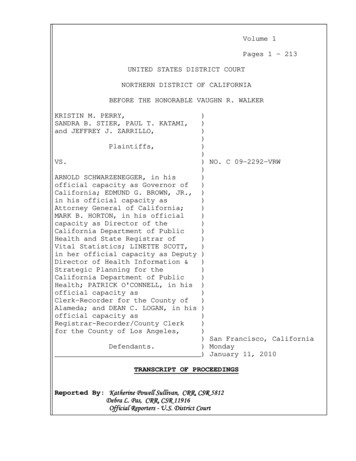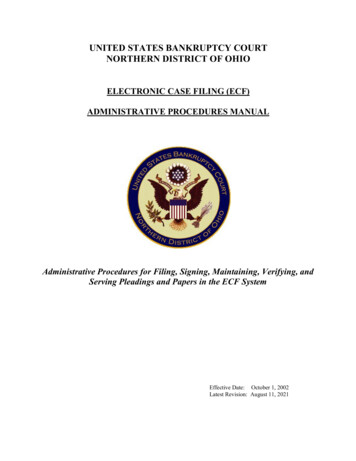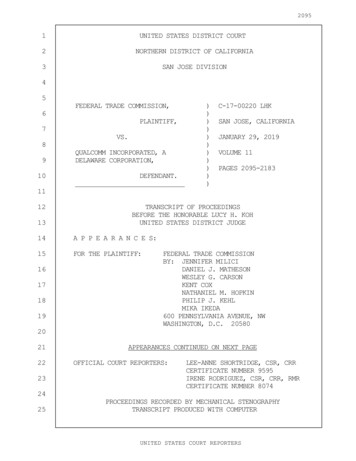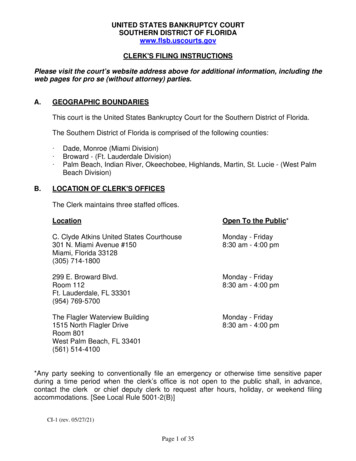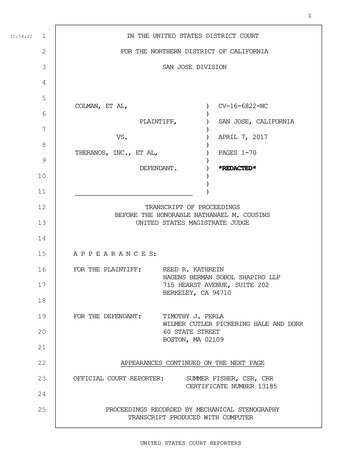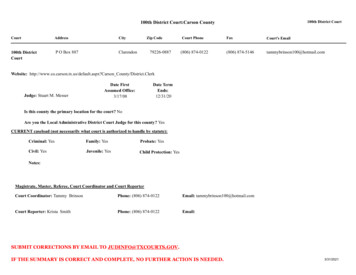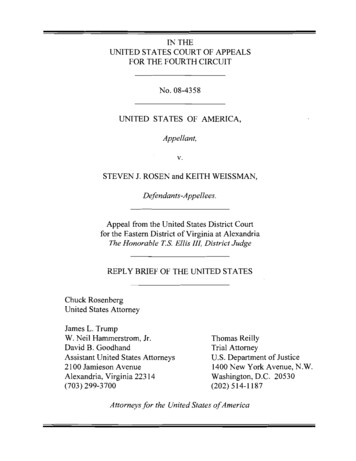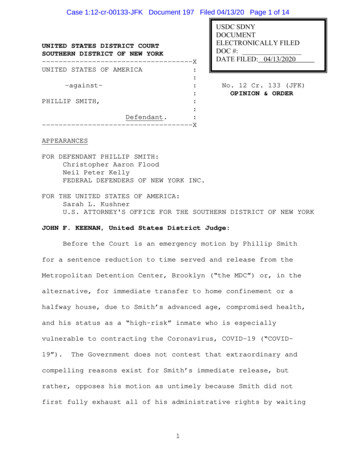
Transcription
Case 1:09-md-02013-PAC Document 57 Filed 09/30/10 Page 1 of 45Case 1:12-cr-00133-JFK Document 197 Filed 04/13/20 Page 1 of 14UNITED STATES DISTRICT COURTSOUTHERN DISTRICT OF NEW YORK------------------------------------XUNITED STATES DISTRICT COURTUNITEDSTATESOF AMERICA:SOUTHERNDISTRICTOF NEW -------------x:In re-againstFANNIE MAE 2008 SECURITIES::LITIGATION::PHILLIP -----------------XUSDC SDNYDOCUMENTELECTRONICALLY FILEDDOC #:DATE FILED: 04/13/2020No.127831Cr.(PAC)133 (JFK)08 Civ.OPINION&ORDER09 MD 2013 (PAC)OPINION & ORDERAPPEARANCESHONORABLE PAUL A. CROTTY, United States District Judge:FOR DEFENDANT PHILLIP SMITH:Christopher Aaron FloodNeil Peter KellyBACKGROUND1FEDERAL DEFENDERS OF NEW YORK INC.The early years of this decade saw a boom in home financing which was fueled, amongFOR THE UNITED STATES OF AMERICA:Sarah L. Kushnerother things, by low interest rates and lax credit conditions. New lending instruments, such asU.S. ATTORNEY'S OFFICE FOR THE SOUTHERN DISTRICT OF NEW YORKsubprime mortgages (high credit risk loans) and Alt-A mortgages (low-documentation loans)JOHN F. KEENAN, United States District Judge:keptBeforethe boomthegoing.Borrowersplayeda role too; theytook onbyunmanageablerisks on theCourtis anemergencymotionPhillip Smiththat thereductionmarket wouldtocontinuerise and thatforassumptiona omwouldthe always beavailable in theDetentionfuture. LendingdisciplineBrooklynwas lacking inthe heMDC”)or, inthe didnot hold these high-riskmortgage loans.Rather thanrising risk on theiralternative,for immediatetransferto carryhometheconfinementorbooks,a theoriginatorssold theirloansthe secondarymortgagemarket,often as ities (“MBSs”).MBSwhomarketsalmost exponentially.andknownhis asstatusas a “high-risk”inmateis grewespeciallyBut thenhousing bubbletheburst.Coronavirus,In 2006, the demandfor housingdropped abruptlyvulnerableto thecontractingCOVID-19(“COVIDand homebegan to fall.In lightof thechangingthathousingmarket, banks traordinaryand theirlending practicesand becameunwillingto refinanceimmediatehome mortgageswithout refinancing.compellingreasonsexistfor Smith’srelease,butrather, opposes his motion as untimely because Smith did not1Unless otherwise indicated, all references cited as “(¶ )” or to the “Complaint” are to the Amended Complaint,firstfully exhaust all of his administrative rights by waitingdated June 22, 2009. For purposes of this Motion, all allegations in the Amended Complaint are taken as true.11
Case 1:12-cr-00133-JFK Document 197 Filed 04/13/20 Page 2 of 1430 days after he sought compassionate release from the Warden ofthe MDC before seeking judicial intervention.For the reasons set forth below, Smith’s motion is GRANTED.He is to be released from the MDC today, April 13, 2020, and his36-month term of supervised release is to commence with theadditional terms imposed below.I.BackgroundOn November 16, 2012, Smith pleaded guilty to conspiracy tocommit access device fraud, in violation of 18 U.S.C. §1029(b)(2), conspiracy to produce false identificationdocuments, in violation of 18 U.S.C. § 1028(f), and aggravatedidentity theft, in violation of 18 U.S.C. § 1028A.On April 10,2013, the Court sentenced him to a term of imprisonment of 120months, to be followed by 36 months of supervised release.Smith has been incarcerated since January 13, 2012.To date, hehas served over 98 months of his original 120-month sentence.Smith is 62 years old and suffers from multiple physicalailments.He has been treated for, among other things, asthma,high cholesterol, blood clots, a thyroid condition, andsuspected multiple myeloma (a cancer of the bone marrow).Smithis currently serving his sentence at the MDC where, as of April13, 2020, four inmates and 12 staff have tested positive forCOVID-19. See COVID-19 Cases, Federal Bureau of Prisons,https://www.bop.gov/coronavirus/ (last visited Apr. 13, 2020).2
Case 1:12-cr-00133-JFK Document 197 Filed 04/13/20 Page 3 of 14The MDC has placed Smith on its list of “high-risk” inmates whoare especially vulnerable to contracting the disease.On April 3, 2020, Smith filed 1 an emergency motion forcompassionate release pursuant to the First Step Act, 18 U.S.C.§ 3582(c)(1)(A)(i), or immediate transfer pursuant to 18 U.S.C.§ 3624(c) and 34 U.S.C. § 60541(g)(1) (“the Motion”).(Emergency Mot. for Sentence Reduction (Apr. 3, 2020), ECF No.185.)The day prior to filing the Motion, however, Smithsubmitted a letter to the Warden of the MDC requesting areduction in sentence pursuant to 18 U.S.C. § 3582(c) or animmediate transfer to home confinement or a halfway housepursuant to 18 U.S.C. § 3624(c) (“the Petition”).(Letter fromNeil P. Kelly, Special Assistant Federal Defender, to DerekEdge, MDC Warden (Apr. 2, 2020), ECF No. 186-3.)Smithsubmitted an addendum to the Petition the following day—the sameday he filed the Motion.(Letter from Neil P. Kelly, SpecialAssistant Federal Defender, to Derek Edge, MDC Warden (Apr. 3,2020), ECF No. 186-4.)On April 7, 2020, the Government filed a letter opposingthe Motion.(Letter from Sarah L. Kushner, Assistant UnitedStates Attorney, to Hon. John F. Keenan (Apr. 7, 2020), ECF No.192.)At that time, according to the Bureau of Prisons (“the1All of Smith’s filings related to his requests for compassionaterelease were made through his counsel.3
Case 1:12-cr-00133-JFK Document 197 Filed 04/13/20 Page 4 of 14BOP”), Smith was scheduled to be released on November 17, 2020,but he may have been eligible for home confinement beginning onMay 17, 2020.(Id. at 1.)The Court scheduled a telephonicconference with parties for April 10, 2020.The morning of the conference, shortly before it was tobegin, the Government filed a letter stating that the MDC hadscheduled Smith to be released to a halfway house on April 23,2020.(Letter from Sarah L. Kushner, Assistant United StatesAttorney, to Hon. John F. Keenan (Apr. 10, 2020), ECF No. 195.)The Government’s letter explained that, consistent with theBOP’s current procedures for inmates scheduled to leave a BOPfacility, the MDC had placed Smith into quarantine on April 8,2020.(Id.)That same morning, Smith filed a response arguingthat his selection for release to a halfway house furthersupported his application for immediate release.10, 2020), ECF No. 196.)(Resp. (Apr.The Motion was heard during twotelephonic conferences with counsel for the Government andSmith. 2At the Court’s request, a representative from the MDC’slegal department joined the second telephonic conference toprovide information regarding the current conditions of Smith’sincarceration and quarantine.2Smith waived his right to appear during the conferences.4
Case 1:12-cr-00133-JFK Document 197 Filed 04/13/20 Page 5 of 14II.Discussion 318 U.S.C. § 3582(c)(1)(A) authorizes a court to modify aterm of imprisonment “upon motion of the [BOP], or upon motionof the defendant after the defendant has fully exhausted alladministrative rights to appeal a failure of the [BOP] to bringa motion on the defendant’s behalf or the lapse of 30 days fromthe receipt of such a request by the warden of the defendant’sfacility, whichever is earlier.” 18 U.S.C. § 3582(c)(1)(A).Where this exhaustion requirement is met, a court may reduce thedefendant’s sentence if it finds that “extraordinary andcompelling reasons warrant such a reduction” and “such areduction is consistent with applicable policy statements issuedby the Sentencing Commission.” Id.In doing so, the Court mustalso consider “the factors set forth in [18 U.S.C. §] 3553(a) tothe extent that they are applicable.” Id.A.ExhaustionCourts are divided on whether the exhaustion requirementmay be waived.On one side, some courts in this Circuit andelsewhere have ruled that the requirement is not absolute, andit may be waived in certain extraordinary circumstances, such asthe threat posed by the COVID-19 pandemic to a specificindividual. See, e.g., United States v. Haney, No. 19 Cr. 5413The Court is grateful to judicial colleagues in this District whosethoughtful analysis of relevant legal issues aided the Court’s own.5
Case 1:12-cr-00133-JFK Document 197 Filed 04/13/20 Page 6 of 14(JSR), Dkt. No. 27, (S.D.N.Y. Apr. 13, 2020); United States v.Sawicz, No. 08 Cr. 287 (ARR), 2020 WL 1815851 (E.D.N.Y. Apr. 10,2020); United States v. McCarthy, No. 17 Cr. 230 (JCH), 2020 WL1698732, at *4 (D. Conn. Apr. 8, 2020); United States v.Zukerman, No. 16 Cr. 194 (AT), 2020 WL 1659880, at *4 (S.D.N.Y.Apr. 3, 2020); United States v. Powell, No. 94 Cr. 316 (ESH),Dkt. No. 98 (D.D.C. Mar. 28, 2020); cf. United States v. Jemal,No. 15 Cr. 570 (JRP), 2020 WL 1701706, at *3 (E.D. Pa. Apr. 8,2020) (“We are not convinced, however, that we must rigidlyadhere to the statutory directive that the BOP be provided up tothirty days to address Defendant’s compassionate releaserequest, without considering a futility exception toexhaustion.”).Many other courts, however, have declined torule that such an exception to the statutory exhaustionrequirement exists. See, e.g., United States v. Knox, No. 15 Cr.445 (PAE), Dkt. No. 1084, at 2–3 (S.D.N.Y. Apr. 8, 2020); UnitedStates v. Roberts, No. 18 Cr. 528 (JMF), 2020 WL 1700032, at *2(S.D.N.Y. Apr. 8, 2020); United States v. Gross, No. 15 Cr. 769(AJN), 2020 WL 1673244, at *2 (S.D.N.Y. Apr. 6, 2020).Here, the Government argues the latter; specifically, thatthe Court must read the statutory exhaustion requirements of 18U.S.C. § 3582(c)(1)(A) strictly, and thus, it does not have theauthority to grant the relief Smith seeks without either a final6
Case 1:12-cr-00133-JFK Document 197 Filed 04/13/20 Page 7 of 14decision by the BOP on the Petition or the passage of 30 dayswithout one.Notably, however, the Government recently argued in afiling before a different court in this District that theexhaustion requirement is non-jurisdictional, which, it argued,allows it to waive the requirement by not raising it as adefense. See United States v. Gentille, No. 19 Cr. 590 (KPF),Dkt. No. 31 (S.D.N.Y. Apr. 6, 2020).In ruling on thedefendant’s compassionate release motion in that case, JudgeFailla “agree[d] with the Government that § 3582(c)(1)(A)’sexhaustion requirement is not jurisdictional, but rather is aclaims-processing rule that the Government can waive by failingto raise an exhaustion argument.” United States v. Gentille, No.19 Cr. 590 (KPF), 2020 WL 1814158, at *3 (S.D.N.Y. Apr. 9,2020); see also Haney, No. 19 Cr. 541, Dkt. No. 27, at 7 (rulingthe exhaustion requirement is non-jurisdictional).After theGovernment waived the requirement, Judge Failla proceeded to themerits of the defendant’s request and granted the motion.Gentille, 2020 WL 1814158, at *4–5; see also United States v.Jasper, No. 18 Cr. 390 (PAE), Dkt. No. 440 (S.D.N.Y. Apr. 6,2020) (letter from the Government waiving the exhaustionrequirement); United States v. Knox, No. 15 Cr. 445 (PAE), Dkt.No. 1086 (S.D.N.Y. Apr. 10, 2020) (same).7
Case 1:12-cr-00133-JFK Document 197 Filed 04/13/20 Page 8 of 14Relatedly, in United States v. Knox, No. 15 Cr. 445 (PAE),Dkt. No. 1088 (S.D.N.Y. Apr. 10, 2020), Judge Engelmayer granteda defendant’s motion for compassionate release after theGovernment reconsidered its initial opposition to the motionbased on the exhaustion requirement and filed a letter waivingthe objection.Prior to the Government’s waiver, however, JudgeEngelmayer had urged the Government “to relent on its invocationof administrative exhaustion as a barrier to judicial action”because “[t]he Court has explicitly stated, based on itssuperior familiarity with [the defendant]’s offense and theapplication of the 18 U.S.C. § 3553(a) factors to hiscircumstances, that he merits compassionate release.” Id., Dkt.No. 1084, at 2, 3 (S.D.N.Y. Apr. 8, 2020).To the Government’scredit, it quickly submitted a letter waiving the exhaustionrequirement, thereby “clear[ing] the way for the immediaterelease of an inmate at high-risk who ha[d] served the vastmajority of his sentence and to whom the COVID-19 viruspresent[ed] a heightened danger while he [wa]s in close custodyat the Metropolitan Correctional Center.” Id., Dkt. No. 1088, at1.Turning now to Smith’s motion and whether the Court has theauthority to modify his term of imprisonment at this time, it isthe Court’s considered view that, in light of the position takenby the Government in this case as well as other recent8
Case 1:12-cr-00133-JFK Document 197 Filed 04/13/20 Page 9 of 14compassionate release cases in this District, the exhaustionrequirement of 18 U.S.C. § 3582(c)(1)(A) does not prohibit theCourt from entering an order granting Smith’s compassionaterelease.First, the BOP’s recent decision to modify Smith’sincarceration to, in effect, grant that portion of the Petitionwhich sought immediate transfer to a halfway house constitutes—at the very least—a partial satisfaction of the exhaustionrequirement.Indeed, the BOP’s grant of early release is insubstance a final decision on that alternate request.Likewise,the willingness of the Government to permit Smith’s earlyrelease constitutes a partial waiver of the exhaustionrequirement because it is, in substance, consent by theGovernment to the BOP’s grant of Smith’s alternate request,which is scheduled to occur immediately after Smith completesthe requisite quarantine procedures for inmates who arescheduled to leave a BOP facility.Second, similar to Knox, the Court has already determinedthat the 18 U.S.C. § 3553(a) factors warrant Smith’scompassionate release.Here, however, the Court need not firstrequest that the Government drop its insistence onadministrative exhaustion because, unlike the Government’sopposition in Knox, No. 15 Cr. 445 (PAE), Dkt. No. 1077, at 3(S.D.N.Y. Apr. 2, 2020), the Government’s opposition to Smith’s9
Case 1:12-cr-00133-JFK Document 197 Filed 04/13/20 Page 10 of 14motion implicitly acknowledges that compassionate release iswarranted: it does not raise any substantive challenge to themerits of the Motion.Finally, the Court is of the opinion that the First StepAct did not empower the Government with the sole authority todecide when and under what conditions exhaustion may be waived,and it agrees with certain of its sister courts that judicialwaiver is permissible in light of the extraordinary threatcertain inmates face from COVID-19. See, e.g., Haney, No. 19 Cr.541 (JSR), Dkt. No. 27, at 11–12 (“[T]he Court concludes thatCongressional intent not only permits judicial waiver of the 30day exhaustion period, but also, in the current extremecircumstances, actually favors such waiver, allowing courts todeal with the emergency before it is potentially too late.”);United States v. Perez, --- F. Supp. 3d ---, No. 17 Cr. 513(AT), 2020 WL 1546422, at *1 (S.D.N.Y. Apr. 1, 2020).Here,Smith’s advanced age and compromised health, combined with hisstatus as a BOP-designated “high-risk” inmate in a facility withconfirmed cases of COVID-19, justifies waiver of the exhaustionrequirement.“No one anticipated today’s circumstances, whereeach day that goes by threatens incarcerated defendants withgreater peril.In essence, the 30-day rule was meant as anaccelerant to judicial review.The Court is charged withinterpreting congressional intent and it would pervert10
Case 1:12-cr-00133-JFK Document 197 Filed 04/13/20 Page 11 of 14congressional intent to treat it as a substantial obstacle toeffective judicial review.” United States v. Russo, No. 16 Cr.441 (LJL), Dkt. No. 54, at 5 (S.D.N.Y. Apr. 3, 2020).In anyevent, whether there is a waiver or not, as the great Cardozoobserved in a completely different context: “The law hasoutgrown its primitive stage of formalism when the precise wordwas the sovereign talisman, and every slip was fatal.” Wood v.Duff-Gordon, 118 N.E. 214, 214 (N.Y. 1917).In other words,substance takes precedence over form.B.Extraordinary and Compelling Reasons for ReleaseTurning to the merits of the Motion, the Court finds thatSmith has set forth “extraordinary and compelling reasons” toorder his immediate compassionate release pursuant to 18 U.S.C.§ 3582(c)(1)(A)(i).First, granting Smith’s request for compassionate releaseis consistent with the 3553(a) sentencing factors and applicablepolicy statements issued by the Sentencing Commission.Smithhas served a sentence that balances the seriousness of hiscriminal conduct with his acceptance of responsibility; theoffense to which he was sentenced and his excellent record whilein custody reflect an individual who is not a danger to thesafety of any other person or to the community; and hisremaining term of incarceration is short.11
Case 1:12-cr-00133-JFK Document 197 Filed 04/13/20 Page 12 of 14Second, Smith’s age and medical conditions—such as hisasthma—place him at a higher risk for developing seriouscomplications should he be exposed to COVID-19 while at the MDCor a halfway house, and would substantially diminish his abilityto provide self-care within those environments. See U.S.S.G. §1B1.13 comment n.1(A)(ii).Indeed, “COVID-19 presents aheightened risk for incarcerated defendants . . . withrespiratory ailments such as asthma.The Centers for DiseaseControl warns that persons with asthma are at high risk ofserious illness if they contract the disease.Further, thecrowded nature of municipal jails . . . present an outsize riskthat the COVID-19 contagion, once it gains entry, will spread.And, realistically, a high-risk inmate who contracts the viruswhile in prison will face challenges in caring for himself.”United States v. Hernandez, No. 18 Cr. 834 (PAE), 2020 WL1684062, at *3 (S.D.N.Y. Apr. 2, 2020) (footnotes omitted).Third, Smith’s counsel represent that they have conferredwith the U.S. Probation Department for the Southern District ofNew York, and they have been advised by Probation that Smith’srelease plan is acceptable and he is not viewed as a safety orflight risk.(Resp. in Supp. Emergency Mot. for SentenceReduction (Apr. 8, 2020), ECF No. 194.)Finally, Smith is like other “high-risk” defendants to whomcourts have recently granted compassionate release. See, e.g.,12
Case 1:12-cr-00133-JFK Document 197 Filed 04/13/20 Page 13 of 14United States v. Harris, No. 18 Cr. 364 (PGG), Dkt. No. 414, at4 (S.D.N.Y. Apr. 8, 2020); Zukerman, 2020 WL 1659880, at *6;Hernandez, 2020 WL 1684062, at *3; but see Haney, No. 19 Cr. 541(JSR), Dkt. No. 27, at 12–16 (denying compassionate releasewhere the defendant did not suffer from a health condition thatmade him unusually vulnerable to the effects of COVID-19 andrelease would have effectively reduced his sentence from 42months to less than nine).Accordingly, the Court concludes that “extraordinary andcompelling reasons” warrant Smith’s release, and that theconditions of his supervised release as outlined below areadequate to protect the community.III.OrderIn view of the above, it is hereby ORDERED that PhillipSmith is RESENTENCED to TIME SERVED plus 36 months of supervisedrelease under the conditions in the original judgment, thus themandatory conditions, standard conditions, and specialconditions of supervised release from Smith’s original sentenceare hereby imposed.It is FURTHER ORDERED that the following additional termsof supervised release are hereby imposed:1.Smith must reside at the location designated in hisfiling of April 8, 2020, ECF No. 194, to which Probation has13
Case 1:12-cr-00133-JFK Document 197 Filed 04/13/20 Page 14 of 14advised would be an appropriate residence for Smith’s release(“the Residence”), until November 17, 2020.2.Smith must self-isolate from others at the Residenceuntil May 31, 2020.3.Smith must not leave the Residence until May 31, 2020,unless he is seeking necessary medical care.In the event thatSmith must leave the Residence to seek such care, Smith shallreport any such medical visits to the Probation Office inadvance.4.Upon his release from the MDC, Smith must immediatelycontact the New York State 24-Hour Coronavirus Hotline (1-888364-3065) and follow the medical and social distancing advice hereceives.5.Smith must call his Probation Officer the day he isreleased, and he must strictly follow the Probation Officer’sinstructions for reporting.It is FURTHER ORDERED that Phillip Smith, Register Number38864-054, be released from the MDC today, April 13, 2020.SO ORDERED.Dated:New York, New YorkApril 13, 2020(lriLJ l (J.!:::.John F. KeenanUnited States District Judge14
Neil Peter Kelly . FEDERAL DEFENDERS OF NEW YORK INC. FOR THE UNITED STATES OF AMERICA: Sarah L. Kushner . U.S. ATTORNEY'S OFFICE FOR THE SOUTHERN DISTRICT OF NEW YORK . JOHN F. KEENAN, United States District Judge: Before the Court is an emergency motion by Phillip Smith for a sentence reduction to time served and release from the
